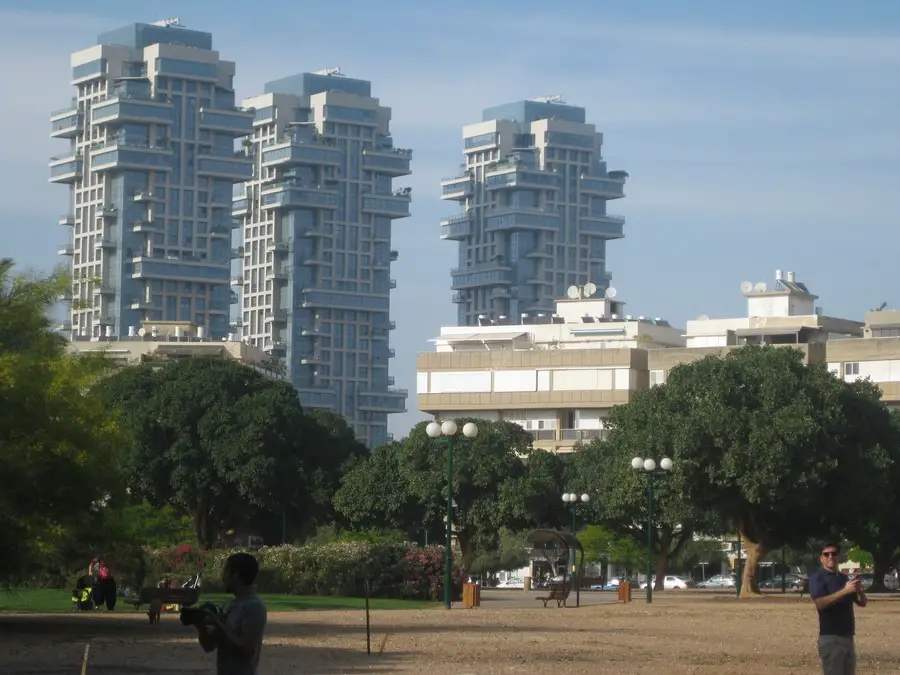Urban Planning, Architecture, New Cities and Communities
Urban Planning : New Cities Design
Architectural Column Vol. II, Number 7 by Joel Solkoff, PA, USA
22 + 21 Sep 2014
Joel’s Column Vol. II, Number 7
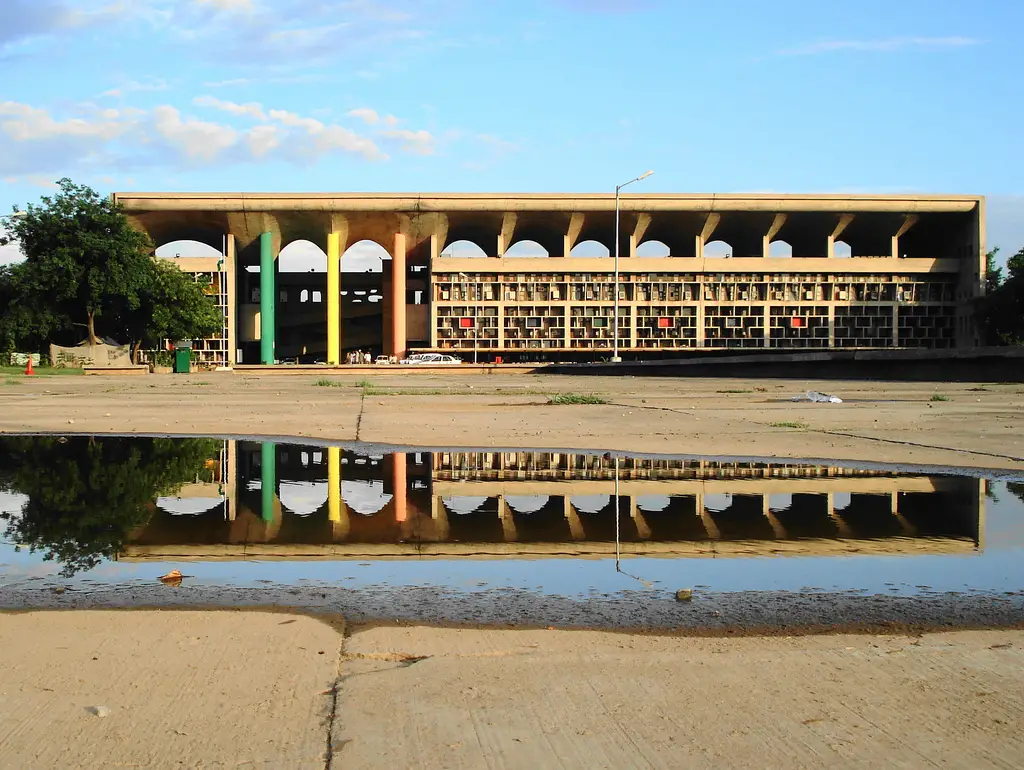
Punjab and Haryana High Court designed by Le Corbusier in the city of Chandigarh. Le Corbusier designed Chandigarh at the request of Indian Prime Minister Jawahar Lal Nehru. The High Court was completed in 1955. Photo courtesy of Wikipedia Commons.
The problem with building cities is knowing how to start
Utopia: “A place of ideal perfection….” Webster’s dictionary
“Civics as an art has to do, not with imagining an impossible [utopia] where all is well, but with making the most and best of each and every place, and especially of the city in which we live.”–Patrick Geddes
Urban planning—what architects need to know
Yes, I know I began today’s column with the photograph of a building Le Corbusier designed in a city he was asked to build by the Prime Minister of India.
I could not resist showing you the Le Corbusier High Court. Sadly, a discussion of this photograph as well as the work of Le Corbusier and other builders of cities will come in a future column.
Also coming:
A lengthy appreciation of a television commercial: Finally someone serious is taking a serious look at the aging of the American people
An invitation to visit Wyoming and suggestions for building a new city of three million people in Albany County, Wyoming Special aerial view of Wyoming
Honor to Patrick Geddes, father of community planning.
I begin this column with a serious appreciation of the contribution Patrick Geddes made to understanding the design of cities. It was Patrick Geddes who planned the city of Tel Aviv.
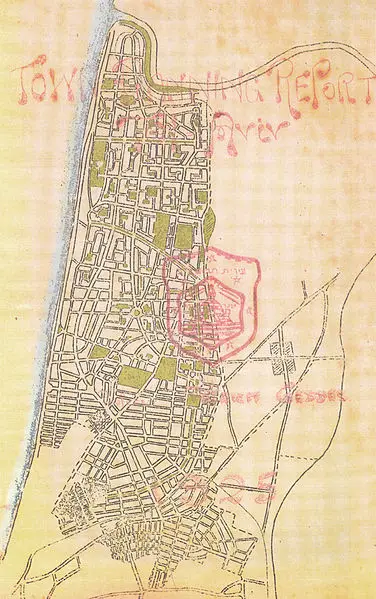
Courtesy of Wikipedia this is Patrick Geddes’ original design for Tel Aviv 1925
More Wikipedia:
“In 1925 Patrick Geddes was commissioned to design a master plan for the city of Tel Aviv. The plan he produced was accepted in 1929. Tel Aviv turned out to be the only example of one of Geddes’ plans being built largely as he envisaged and is a good example of an early planned city.”
Tel Aviv today
For more photographs and video of Tel Aviv architecture, go to: Tel Aviv Architecture Photos
–
Sometimes critical of the object of my own enthusiasm (one has to be carefully sometimes), I consulted with a real live town planner to double check on the application of Patrick Geddes (1854-1932) to the real world.
Published with his permission is Ed LeClear’s response to my enthusiasm for Geddes:
Joel,
I just received your message. Yes, Geddes. I did have the pleasure of reading Peter Hall’s excellent book “Cities of Tomorrow” in graduate school wherein he writes fairly extensively about Geddes. I also enjoyed reading one of his intellectual descendants – Benton MacKaye – while doing some zoning work on the Appalachian Trail. It has been fifteen years, so I cannot cite chapter and verse; however, any regional planner is indebted to Geddesian theory and the thought that we must “survey before plan.” I think he wrote that we must diagnose before designing a treatment. I have always embraced the ethic that we as planners must understand how our community works before we can seek to shape its form, function and direction.
I need to prepare for my next meeting, but I would enjoy talking with you more about planning theory sometime. Are you a coffee drinker?
Best regards,
Ed LeClear, AICP
Director | Planning & Community Development
Borough of State College, PA
eleclear(at)statecollegepa.us
“Planners must understand how our community works before we can seek to shape its form”
The problem with appreciating Geddes is Geddes makes appreciating him difficult.
It was not until Lewis Mumford, the greatest architectural critic of the 20th Century, published his landmark work on cities that a coherent explanation of Geddes’ genius became truly understandable.
The is how Hellen Meller complained in her Preface to Patrick Geddes, Social evolutionist and city planner:
“I first came across Geddes’s work when as a postgraduate student; I found a copy of his Dunfermline Report in the stacks of Bristol University. I was fascinated by it and wanted to find out more about the author. I had no idea where my quest would take me. Geddes had been like the Holy Grail and I have had to go through fire and water in my pursuit of him! His quicksilver character, his obscure methods of working, and the weight of the devotion of his disciples has sometimes left me in the slough of despond; but the very reverse has been true with much else.”
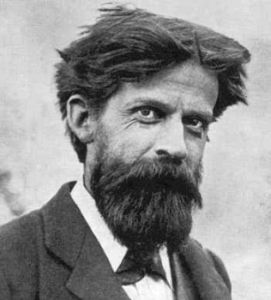
Photo of Patrick Geddes courtesy Wikipedia.
Dunfermline Report
The first paragraph of the Dunfermline Report which influenced Hellen Meller to become a Geddes biographer reads:
“As title and treatment indicate, this volume is one of practical purpose. Its main contents are a plan and plea for conserving and developing the amenities of a small provincial city, and its constructive proposals are based on a photographic survey of its present, a rereading of the past. The work was not only planned, essentially done, independently of publication, but unexpectedly numerous inquiries from many centres, British and foreign have shown that the ideals with which it deals are fully sturring, and that the demands it is here sought to supply are widely felt. I have, therefore, to return my thanks to the Carnegie Dunfermline Trust, not only for their appreciative minute of reception of the volume, for following this up by according permission for its being now made public.”
Read the entire Dunfermline Report if you wish.
Hint to architects. It will impress your boss if your boss knows you are reading the Dunfermline Report. Good luck to you. You will need it.

Courtesy of Wikipedia I leave you with a photograph of Geddes home about which London’s New Statesman said many acid things
Lewis Mumford. Lewis Mumford. Lewis Mumford
It is easier to go straight to Lewis Mumford who served as the great man’s Aaron, in keeping with the Biblical story. The story says Moses could not speak the word God spoke to him because he burnt his tongue with a fiery coal. Instead, Moses whispered in his brother Aaron’s ear and Aaron spoke God’s word beautifully.
–
Earlier this year, I had emotionally disturbing tests to find out whether I continue to have kidney cancer and whether a tumor which had developed on my chest was cancerous. After surgery, the pathologist said I have not developed another cancer. Indeed, I have now survived cancer three times.
In celebration, I wanted to read something meaty. Something important and significant. The name Lewis Mumford popped into my mind.
–
Here is Wikipedia on Lewis Mumford:
“Lewis Mumford, KBE (October 19, 1895 – January 26, 1990) was an American historian, sociologist, philosopher of technology, and literary critic.
“Particularly noted for his study of cities and urban architecture, he had a broad career as a writer.
“Mumford was influenced by the work of Scottish theorist Sir Patrick Geddes and worked closely with his associate the British sociologist Victor Branford.
“Mumford was also a contemporary and friend of Frank Lloyd Wright, Clarence Stein, Frederic Osborn, Edmund N. Bacon, and Vannevar Bush.”
–
The beauty of Lewis Mumford’s writing dazzled me. Here he writes about cities especially his beloved New York:
–
“Since I have spent no small part of my life wondering about cities, studying cities, working in cities, stirred by all their activities, this original envelopment by the city constitutes an important clue in my life. Certainly Manhattan provided a far from ideal environment during the years I was growing up in it; but it had many rewarding features, natural and man-made that have since dropped away or been wiped out. This has come about partly through the profitable congestion of tenements and skyscrapers, partly through the more ominous spread of violence and lawlessness, which, in the city of my youth, used to be confined, like a carbuncle, to certain self-imposed areas, like Bowery and Hell’s Kitchen. Such quarters had not yet poured their infection into the whole bloodstream of the city.”
–
Joel’s note: The decline in crime in New York City over the past decade comes as a pleasant but startling surprise. When I was in college at Columbia, saying, “I was only mugged once” had special significance. It meant I was lucky not to experience worst. Many classmates and Barnard women and faculty members went about their daily tasks cautioning themselves not to walk in dangerous areas—portions of streets—so as to avoid being robbed, hurt, or raped. Now, Renzo Piano is building an annex to Columbia in a neighborhood so dangerous during my student days that Sudden Safety surprises me. The trouble with New York City is that I could never afford to live there.
–
Joel recommends: Purchasing The Lewis Mumford Reader lovingly edited by his protégée and biographer Donald L. Miller, Pantheon Books, New York, 1986.
–
Miller’s introduction to the anthology begins:
“This book brings together a representative selection of the major writings of Lewis Mumford, one of the most influential thinkers of our time. Mumford is a writer of audacious reach. His contributions to history, philosophy, literature, art, and architectural criticism, urban planning and the study of cities and technology have opened for fresh consideration large areas of the human achievement. Over a lifetime of steady effort, he has produced a body of cultural criticism and commentary that for its range and richness is unmatched in modern American letters. ‘It may be,’ Malcolm Cowley has suggested, ‘that Lewis Mumford is the last of the great humanists.”
–
Mumford taught me to study the community in which I live. More importantly, he reassured me that I myself have been studying all along. I have been influenced by design since I was a child. My 1995 paraplegia taught me that I had to pay more attention to design if I were to survive.
What lesson have I learned from all this reading? Taking stock. Where do I live? For the past 10 years I have lived in State College, PA. How do I make use of the injunction quoted at the beginning of this column and made comprehensible to me by Lewis Mumford?
“Civics as an art has to do, not with imaging an impossible [utopia] where all is well, but with making the most and best of each and every place, and especially of the city in which we live.” –Patrick Geddes
Isn’t the answer to where I should start planning is where I live, where I can make a contribution?
Mayor Elizabeth Goreham, Jon Eich, and the Planning Commission for the Borough of State College
Borough of State College Film on YouTube
The above 10 minute video was published by permission of the Borough of State College. Copyright 2014 by C-Net.
This is how I describe myself in the third person in the About section of e-architect’s YouTube site:
“E-architect columnist Joel Solkoff, at the request of State College Mayor Elizabeth Goreham, proposes two ordinances requiring new houses and housing units of fewer than four be accessible so a person with a mobility disability can visit. The visitability movement was created by Eleanor Smith, founder of Concrete Change. Fifty municipalities in the U.S. have already adopted visitability ordinances withholding building permits for small housing units which do not contain a wheel chair accessible entrance, a door wide enough to get in, and a half-bathroom on the main floor with a wide doorway.”
My calling to be a Solon in the small borough in State College came about because I know the mayor.
Earlier this year, I asked Mayor Elizabeth Goreham for an interview in her office in front of the seal of the Borough of State College. The lengthy interview for e-architect focused on the subject of saving small towns like State College so they can serve as communities where everyone can live productively.

Courtesy of Wikipedia, the red shows the area in Pennsylvania where State College is located
The mayor and I are on a first name basis. We hug when we see each other. Two years ago, there was a serious fire alarm problem at the nursing home in which I live. The Mayor was there for me. The fire chief solved the problem with the help of the police chief—each of whom I have come to know well.
Elizabeth introduced me to Jon Eich, a former Centre County Commissioner and a member of the planning boards for the Borough of State College and the Region. Jon Eich told me about the visitability movement. Before I knew it I was testifying before a public commission not realizing it was being broadcast on television.
Local politics in the Borough of State College is astonishingly complicated. It reminds me of tasteless jokes about Luxembourg’s size during my sadly brief sojourn to the Grand Duchy of Luxembourg. The Borough Council passed an ordinance allowing four live chickens to reside in the Borough.
The staff of the Borough is superb. Plus a lot of earnest and talented people give their time and intense attention even in long meetings on zoning that go on for two hours.
The Mayor asked me to run as a candidate for the Borough Council next year. As a member of the Council I would have the power to vote on zoning-related issues that affect the elderly and disabled in this community. I would be given a greater voice in my efforts to integrate the Borough of State College so it benefits from the cash-laden community of retirement villages that surround us.
The temptation to run for public office is intoxicating. If I do decide to run, you will be the second to know. First, if I announce, I must announce in the Borough of State College, PA rather than in Scotland where e-architect’s staff is not registered to vote in U.S. elections.
Good night and good luck,
Joel
Copyright © 2014 by Joel Solkoff. All rights reserved.
Joel Solkoff – regular guest editor at e-architect
Location: USA
Joel Solkoff’s Column Vol.II, Number 3
Joel Solkoff’s Column Vol.II, Number 2
Joel Solkoff’s Column Vol.II, Number 1

photo : The Crescent a 1938 Art Deco hotel, Henry Hohauser architect, photo courtesy of the City of Miami Beach, Florida
J.P. Morgan Library and Museum Building, New York City, USA
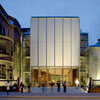
photo by Michel Denancé, provided by permission of the Morgan Library and Museum
J.P. Morgan Library and Museum Building : architecture article by Joel Solkoff. 13 Jul 2013
Comments / photos for the Urban Planning – Joel Solkoff’s Column Vol.II, Number 7 page welcome

